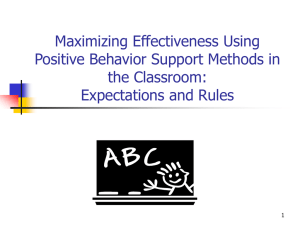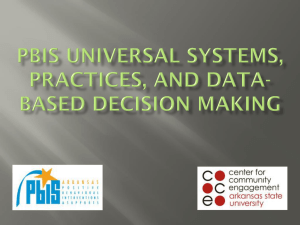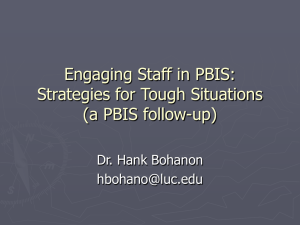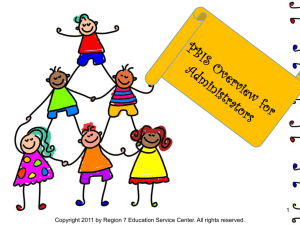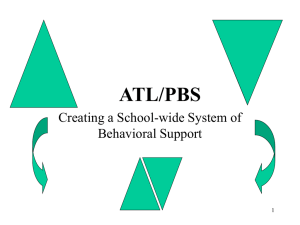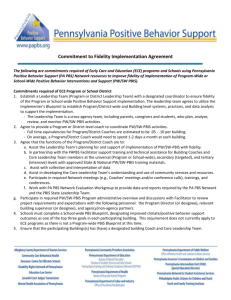What is SW-PBIS? School-wide positive behavior interventions and
advertisement
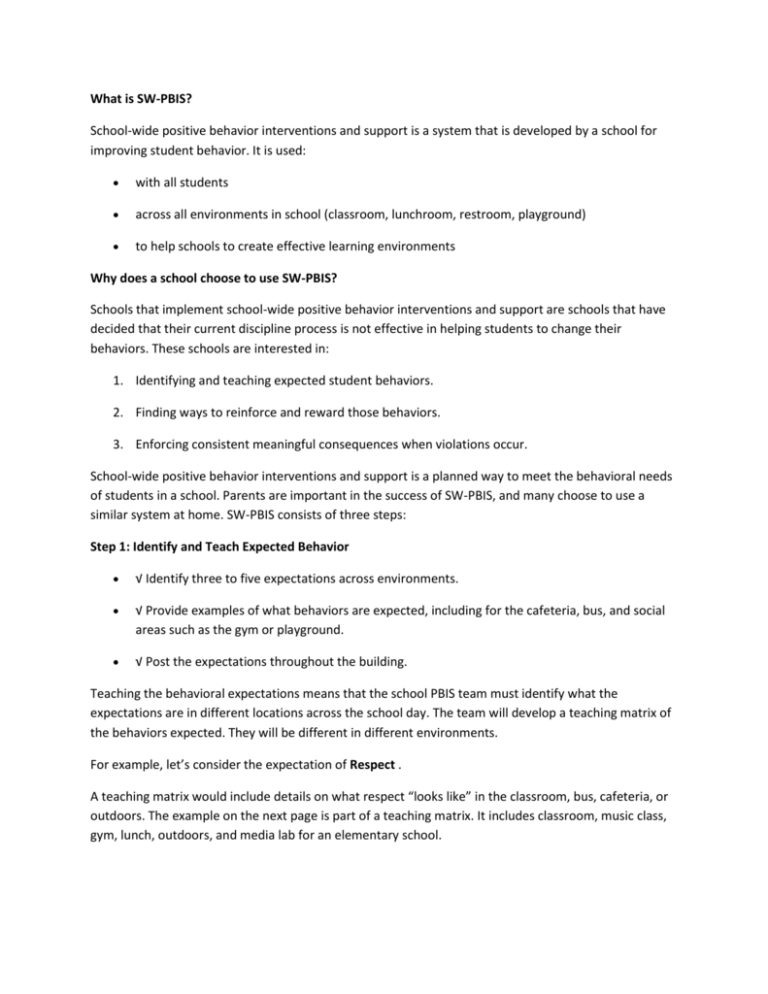
What is SW-PBIS? School-wide positive behavior interventions and support is a system that is developed by a school for improving student behavior. It is used: with all students across all environments in school (classroom, lunchroom, restroom, playground) to help schools to create effective learning environments Why does a school choose to use SW-PBIS? Schools that implement school-wide positive behavior interventions and support are schools that have decided that their current discipline process is not effective in helping students to change their behaviors. These schools are interested in: 1. Identifying and teaching expected student behaviors. 2. Finding ways to reinforce and reward those behaviors. 3. Enforcing consistent meaningful consequences when violations occur. School-wide positive behavior interventions and support is a planned way to meet the behavioral needs of students in a school. Parents are important in the success of SW-PBIS, and many choose to use a similar system at home. SW-PBIS consists of three steps: Step 1: Identify and Teach Expected Behavior √ Identify three to five expectations across environments. √ Provide examples of what behaviors are expected, including for the cafeteria, bus, and social areas such as the gym or playground. √ Post the expectations throughout the building. Teaching the behavioral expectations means that the school PBIS team must identify what the expectations are in different locations across the school day. The team will develop a teaching matrix of the behaviors expected. They will be different in different environments. For example, let’s consider the expectation of Respect . A teaching matrix would include details on what respect “looks like” in the classroom, bus, cafeteria, or outdoors. The example on the next page is part of a teaching matrix. It includes classroom, music class, gym, lunch, outdoors, and media lab for an elementary school. Teaching Matrix Class Music Take turns Follow teacher directions Use appropriate voice level Use manners Look at teacher Listen Gym Lunch Outdoors Be a good listener Say Please and Thank You Treat the equipment properly Take turns Listen to adult direction Treat others the way you want to be treated Media/Lab Use the computers, books, magazines, and furniture correctly Use inside voices This is part of a teaching matrix. Notice the lunchroom and outdoor recess expectations. The entire staff including the lunchroom and recess staff would teach all students these expectations through lessons, role-playing, and practice. Instead of punishing students for not following the expectations, staff would focus more on the positive (expected) behaviors through a reinforcement and reward system. Step 2 Positively Reinforce and Reward Expected Behaviors When students meet school-wide expectations, school staff will note their success with positive reinforcement. This might include praise or coupons that can be used to purchase items at school. It might include weekly drawings for rewards, special privileges, or recognition during student assemblies. All staff (principal, teachers, lunchroom staff, bus drivers, librarians, janitor, etc.) would use the system. Step 3 Enforce Meaningful Consequences for Violations In addition to teaching and rewarding positive behaviors, the school will identify a consistent way to respond to problem behavior when it occurs. The strategies to address challenging behaviors will be shared with students, staff, and parents. This will help everyone to know what behaviors violate the expectations. The process should be shared with families in the school discipline handbook as well as through regular reports. Problem behaviors typically fall under the categories of minor or major problems. √ Minor behaviors are dealt with by building staff or the classroom teacher √ Major violations are managed by administrative staff Levels of School-Wide Support Schools that use SW-PBIS create and maintain supports to meet the needs of all students. These supports are based on the understanding that specific behaviors need to be taught, not just expected. However, even with PBIS in place, about 5-10% of students will need additional support to be successful. A continuum of support is described below. 1. Universal system of support (school-wide behavior support): Behavioral support is provided for ALL students throughout the school. These supports include: √ Social skills instruction √ Positive discipline that is proactive √ Behavior expectations that are taught √ Active supervision and monitoring √ Positive reinforcement √ Fair and corrective discipline √ Parent training and collaboration 2. Small group systems of support: This level of support provides additional help for 10-15% of students who need more support. Interventions are more intensive and are for a smaller number of students. They are often provided in small groups, and include: √ Social skills groups √ Conflict resolution √ Self management programs √ Adult mentors (checking in) √ Small group instruction √ Special seating or special schedule 3. Targeted systems of support (focused on the individual child): Intensive, individual supports for a few students with problem behaviors. These supports are used when universal and group/classroom supports are not effective in teaching behavioral skills in all settings. About 5%-10% of students need this more intensive level of support. It includes: √ Individual academic support (IEP/504) √ Intensive social skills instruction √ Functional behavior assessments (FBA) √ Behavior intervention plans (BIP) √ Supervision and monitoring √ Interagency collaboration √ Intensive collaboration with family √ Intensive family-based interventions, when appropriate Family Involvement in PBIS Teaching a behavior that schools expect to see works best when there is consistency across home and school settings. When a child has challenging behavior at school, a strong partnership between the school and family is important. Family involvement is a key feature when developing positive behavior support plans for students with special needs. School-wide positive behavioral interventions and support is a school-wide approach to helping all children learn to self-manage behaviors. However, parent involvement is really important in all aspects of SW-PBIS. When parents are involved, outcomes for children are better. Participating in a school-wide PBIS initiative is more than volunteering to help with a school field trip or help out in the classroom. It is a willingness to help participate in your own child’s positive behavioral support program, and to participate in SW-PBIS planning to help other families. The following suggestions are different ways that parents can be involved in SW-PBIS. School-Wide √ Learn about PBIS o Read materials offered by your child’s school related to PBIS o Learn about the school’s PBIS model √ Participate in PBIS planning o Help the school to understand family priorities and issues o Help the school understand community cultural values, beliefs and practices o Participate in discussions to build family and school agreement on school-wide expectations for behavior √ Use PBIS strategies in home and community environments o Teach behavior expectations to your children o Use and reinforce PBIS strategies at home and in the community √ Help build parent participation in school-wide PBIS o Help other families understand PBIS o Link with and support other school families √ Help get community involved o Link with community resources and actively engage community supports for the school’s efforts. (i.e. Search for donations and free resources in the community for PBIS reinforcement programs.) √ Small Group o Help the teacher to understand your family’s values, beliefs and practices o Help school staff to develop and implement “targeted” interventions for your child √ Individual o Participate on your child’s individual behavior support team, if he or she has one o Share your child’s strengths and needs in order to develop a behavior plan o Help the team to understand strategies that are most acceptable to you o Advocate for your child’s needs with other team members o Review outcome data to determine if the behavior plan are effective Traditional way of dealing with problem behaviors through punishment is not effective in changing behavior. It is exciting to see schools adopt school-wide PBIS, because the model approaches behaviors as skills that need to be developed. It approaches behavior as an instructional need. It addresses parent concerns with safety for all children. It helps schools create effective environments that improve teaching and learning. Parents of children with behavior challenges are important in a system of school-wide positive behavior interventions and supports because they already know that punishment does not teach skills. Parents already know what individual strategies may work with their own child. Parents are important contributors in developing SW-PBIS in their child’s school, because parents have a great deal at stake – the lives and futures of their children. By becoming involved, parents can have a vital role in improving school climate, safety, and instructional time. Most important, parents can have a role in helping their child to develop the positive behavior skills that are the foundations for a successful future.

